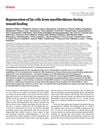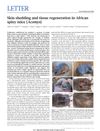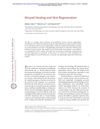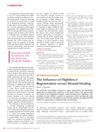Sustained Postnatal Skin Regeneration Upon Prenatal Application of Functionalized Collagen Scaffolds
November 2019
in “
Tissue Engineering Part A
”
TLDR Functionalized collagen scaffolds applied prenatally greatly improve skin regeneration.
The study investigated the effects of prenatally applied functionalized collagen scaffolds on postnatal skin regeneration in sheep with full-thickness skin defects. The scaffolds, enhanced with heparin, VEGF, and FGF2, significantly improved skin regeneration, increasing the surface area by 6.9 times compared to collagen-only scaffolds. Initially, epidermal thickness increased 5.7 times before decreasing over time. The scaffolds also promoted gene expression related to the extracellular matrix and hair follicles, supporting new hair follicle generation. These findings suggested that such scaffolds could be beneficial for prenatal treatment of closure defects like spina bifida, offering long-term skin regeneration and growth.






